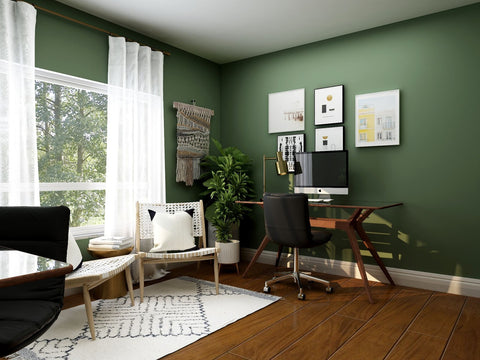
How To Decorate The Japandi Way: Tips and Tricks For You
Uncluttered without being boring and simple while being warm - that’s the Japandi way. The interior decor style is an intersection of the Japanese and the Scandinavian (“Scandi”) style, both aesthetically and philosophically.
It is no wonder that Japandi has taken the interior decor world by storm - it appears that the Japandi way is the perfect antidote to the chaos that dominates our modern world. Given the events of 2020, especially, the simple, mindful, and accepting nature of Japandi has become all the more charming.
It does make one wonder, though: how did this style come to be? What are the elements that define Japandi? And, perhaps, what can we learn from Japandi and emulate in our own homes?
The Philosophy of Japandi
Japandi is a marriage between Japanese minimalism with Scandinavian design. The common factor? Despite the vast geographical distance between the two, the core design principle that guides the two is very similar: an appreciation of functionality and simplicity and the use of natural elements as a way of life.
The fusion of Japanese Zen is built through a seamless flow between outdoor and indoor spaces, embracing the imperfections and staying rooted, and Scandinavian style, which is simple, clean, airy and minimalist.
Scandi style maximises sunlight, letting it flood the house and brighten up the space. There’s not much ornamentation. It is the minimal decor, simple shapes and uncomplicated patterns that define Scandinavian interior decor style. Japandi, the answer to your inner Zen-loving decor enthusiast, gives a fresh and breezy appeal to Japanese decor sensibilities, and in turn, Scandi warmly embraces earthy tones and the little imperfections of nature.

A typical minimal Japandi space. Courtesy of Influx Interiors.
Wabi-Sabi
Wabi-Sabi is embracing the imperfect, the broken, the impermanent and putting it back together in beautiful ways. The concept takes from nature, where perfection is a myth. After all, trees don’t grow in a straight line, and rivers don’t flow in one direction. There is respect for the rustic, fragile and melancholic passing nature of life, and it is this idea that has been translated into home decor with Wabi-Sabi. It values quality over quantity, handcrafted, well-loved and lived-in over industrial, sharp or bold items.
Hygge
Hygge, pronounced Hoo-guh, is a Danish word that means cosy, warm and comfortable. It fosters a feeling of well-being and warmth. Setting up a Hyggekrog - a cosy corner in the house - is usually the first step towards the Scandi bit of Japandi. Think: setting up a fireplace, having loads of plants around, and incorporating neutral and warm colourways.
Commitment to sustainability
Being mindful of the elements we choose to bring into our space is essential to the Japandi style. Sustainability lies at the centre - this does not only mean bringing in organic elements such as wood, bamboo, and coconut shells in our space but also bringing in greenery in the form of plants.
Colour palette used in Japandi interiors
The Japanese style of interior features a palette of warm earthy tones like Red, Rust, Brown, Green, Olive, Sage, Jade and neutrals like Beige. Wooden furniture is medium to deep-toned, and together this symphony creates a feeling of tranquillity and rootedness.
The Scandi palette, too, consists of natural tones. It also consists of cooler tones (we’re talking blues, whites, and greys), and this really helps bring in a bit of contract. Japandi works by bringing together warm earthy tones with simple and uncomplicated accents, for example, juxtaposing an olive-coloured wall with light wood furniture.

The juxtaposition of colours creates visual interest. Courtesy of Collov Home Design.
Japandi Décor: By The Elements
Japanese decor is replete with patterns that add just the right amount of pizzazz. Introducing these as a framed art or a subtle wallpaper enlivens the space while maintaining the calmness of Japandi.
Accent Walls and Ceilings
Incorporate subtle limewash walls, experiment with exposed concrete, decorating the walls with the choicest origami pieces, using wooden slats or bamboo on an entire wall works wonders to add textures and patterns to an otherwise Plain Jane wall.

Furniture and Furnishings
It is a great idea to introduce diversity in texture through natural elements like a timber stool, terracotta pot, hemp curtains, paper lanterns, and cane furniture. Hey, maybe take a look at these cushions by Studio Covers - solids and texture are easy ways of adding layers to your space.
Plants, plants, plants
Plants help bring a sense of oneness with nature along with a pop of colour. But remember to not go overboard with the green as it may seem cluttered. A monstera here and a snake plant there and you’re golden. Another popular Japandi technique? A statement wall with a vertical garden, of course!

Creating Visual Interest in a Japandi Style Home
When it comes to creating visual interest in a Japandi home, one cannot go wrong with black as an accent. Use it on a wall or in contrast with the neutrals and whites. Or, if you fancy a delicate touch, go for a wispy ink painting in black to create some visual drama. Or better still, go bold with a set of black and grey cushions and instantly amp up the style quotient.

Another trick that tantalizes visually is to play with a complementing colour palette and layering them through decor, as demonstrated here. Our guide on how to layer cushions like a pro that would come in handy.
To Sum It Up
1. Be mindful of your space and be intentional about the decor pieces you choose to bring into this space.
2. Purpose and functionality over clutter.
3. Stick to clean, basic, and simple shapes.
4. Avoid bright pops of colours.
5. Blur the lines between indoors and outdoors, say, via a sliding glass door.
6. Go all the way for handwoven and handcrafted decor and furniture items; the closer to nature, the better.
 Illustration of how the interiors merge into the exteriors via a sliding glass door in Japandi. Courtesy of Jack Zhang.
Illustration of how the interiors merge into the exteriors via a sliding glass door in Japandi. Courtesy of Jack Zhang.
We hope this Japandi train took you places and inspired you to start creating your own Hyggekrog in the middle of chaos. To sum it up, remember to keep it real, raw and embrace imperfections as you go, and before you know it, Japandi will become more than an interior style, a way of life.








Leave a comment